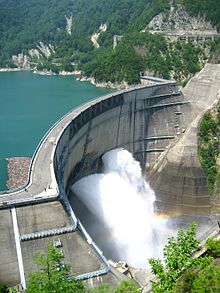Kurobe dam
| Kurobe dam 黒部ダム |
|
|---|---|

View of Kurobe Dam, orifice floodgates discharging water
|
|
|
Location of Kurobe dam
黒部ダム in Japan |
|
| Location | Toyama Prefecture |
| Coordinates | 36°33′59″N 137°39′41″E / 36.56639°N 137.66139°ECoordinates: 36°33′59″N 137°39′41″E / 36.56639°N 137.66139°E |
| Purpose | Power, water supply |
| Status | Operational |
| Construction began | 1956 |
| Opening date | 1963 |
| Construction cost | ¥51.3 billion $142.5 million (1963) |
| Operator(s) | Kansai Electric Power Company |
| Dam and spillways | |
| Type of dam | Arch, variable-radius (dome) |
| Impounds | Kurobe River |
| Height | 186 m (610 ft) |
| Length | 492 m (1,614 ft) |
| Width (crest) | 8.1 m (27 ft) |
| Width (base) | 39.7 m (130 ft) |
| Dam volume | 1,582,845 m3 (2,070,283 cu yd) |
| Spillway type | Service, uncontrolled overflow |
| Spillway capacity | 906 m3/s (32,000 cu ft/s) |
| Reservoir | |
| Creates | Kurobe Lake |
| Total capacity | 199,285,175 m3 (161,563.121 acre·ft) |
| Catchment area | 188.5 km2 (72.8 sq mi) |
| Surface area | 3.49 km2 (1.35 sq mi) |
| Power station | |
| Operator(s) | Kansai Electric Power Company (KEPCO) |
| Commission date | 1961-1973 |
| Type | Conventional |
| Turbines | 4 x Pelton-type |
| Installed capacity | 335 MW |
| Annual generation | 1 billion kWh |
|
Website http://www.kurobe-dam.com/ |
|
The Kurobe Dam (黒部ダム?) or Kuroyon Dam (黒四ダム?), is a variable-radius arch dam on the Kurobe River in Toyama Prefecture on the island of Honshū, Japan. It supports the 335 MW Kurobe No. 4 Hydropower Plant and is owned by Kansai Electric Power Company. At 186 metres (610 ft) in height, it is the tallest dam in Japan. It was constructed between 1956 and 1963 at a cost of ¥51.3 billion yen. The project was a difficult engineering feat for the rapidly growing post–World War II Japan, and claimed the lives of 171 people.
In 1951, the Kansai Electric Power Company was formed to provide electric power for the Kansai region of Japan. Shortly after their formation, the area suffered from drought which caused power rationing. The drought along with the rapid growth of post–World War II Japan pushed the company to increase their generating capacity. After a series of geological and hydrological studies of the Kurobe River and Gorge, it was announced in late 1955 that the Kurobe Dam would be constructed.
In July 1956, construction on the dam began. Problems quickly arose while transporting material to the construction site as only one small railway existed through the narrow gorge. Kansai decided to construct the 5.4 kilometres (3.4 mi) Kanden Tunnel under Mount Tate that could bring supplies from Ōmachi eastward towards the construction site. The tunnel proved an arduous task as a large fracture zone in the rock was encountered which took seven months to repair. In September 1959, the first concrete for the dam was placed and by October of the next year, the reservoir had begun to fill.
...
Wikipedia

